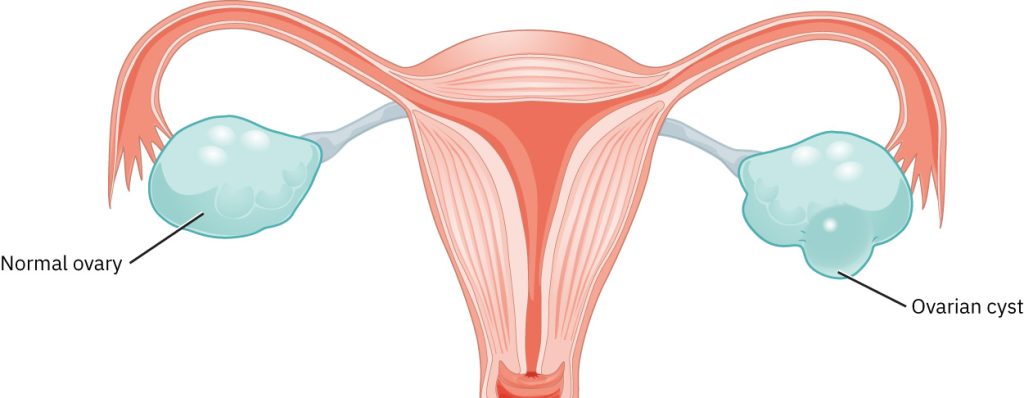18.15 Ovarian Cysts
An ovarian cyst is a blood- or fluid-filled sac that forms on or inside the ovary. Most ovarian cysts resolve on their own, but some may cause pain or other symptoms requiring treatment. See Figure 18.15[1] for an illustration comparing a normal ovary and an ovary with an ovarian cyst. The most common types of ovarian cysts are functional cysts that form during the menstrual cycle and are usually benign. Functional cysts may be follicle cysts or corpus luteum cysts. When an ovum matures every month, the follicle breaks open to release the ovum. Follicle cysts form when the follicle doesn’t break open to release the ovum and continues to grow into a cyst. Follicle cysts are often asymptomatic and spontaneously resolve in one to three months. Corpus luteum cysts form after the follicle breaks open and releases the ovum, but the empty follicle sac doesn’t shrink. Instead, the sac reseals itself after the egg is released, and fluid builds up inside the sac. Most corpus luteum cysts resolve after a few weeks, but some can grow to almost four inches in diameter. While most small ovarian cysts are asymptomatic, large cysts can bleed, rupture, or cause fallopian tubal torsion (twisting) resulting in severe pain and possible necrosis.[2]

Nonfunctional ovarian cysts may be caused by pelvic infections, endometriosis, polycystic ovary syndrome, or cancer. Women with endometriosis can develop an endometrioma when the endometriosis tissue attaches to the ovary and forms a growth. These cysts can be painful during sex and during the menstrual period. Polycystic ovary syndrome (PCOS) causes ovaries to make many small cysts that can result in infertility. Malignant ovarian cysts that cause ovarian cancer are rare and more common in older women.[3]
Read more about PCOS in the “Polycystic Ovary Syndrome” section.
Ovarian cysts are diagnosed by ultrasound. Symptomatic or large (>10 cm) cysts are removed by laparoscopic ovarian cystectomy, with the goal of preserving normal ovarian tissue and fertility.[4]
If a large ovarian cyst ruptures, it can cause acute, unilateral, lower abdominal pain, classically in the midmenstrual cycle. Rupture may be accompanied by intraperitoneal hemorrhage that may be self-limited or can lead to hemodynamic instability. Women with known ovarian cysts who suddenly develop severe abdominal pain should be evaluated urgently for possible ovarian or tubal torsion. Ovarian and/or Fallopian tubal torsion requires emergency surgery.[5]
- “0e4c3e1ee4d8bc063219ba1ff4b58b46de323ca8” by Rice University/Open Stax is licensed under CC BY 4.0. https://openstax.org/books/maternal-newborn-nursing/pages/6-3-benign-growths ↵
- Office on Women’s Health. (n.d.). Ovarian cysts. https://womenshealth.gov/a-z-topics/ovarian-cysts ↵
- Office on Women’s Health. (n.d.). Ovarian cysts. https://womenshealth.gov/a-z-topics/ovarian-cysts ↵
- Laufer, M. R. (2024). Ovarian cysts in infants, children, and adolescents. UpToDate. https://www.uptodate.com/ ↵
- Laufer, M. R. (2024). Ovarian cysts in infants, children, and adolescents. UpToDate. https://www.uptodate.com/ ↵
A fluid-filled sac that forms on or inside the ovary. Most ovarian cysts are benign and go away on their own, but some may cause pain or other symptoms and require treatment.
Forms when the follicle doesn't break open to release the ovum and continues to grow into a cyst.
form after the follicle breaks open and releases the ovum, but the empty follicle sac doesn't shrink
Twisting of the fallopian tubes resulting in severe pain and possible necrosis.
When the endometriosis tissue attaches to the ovary and forms a growth.

